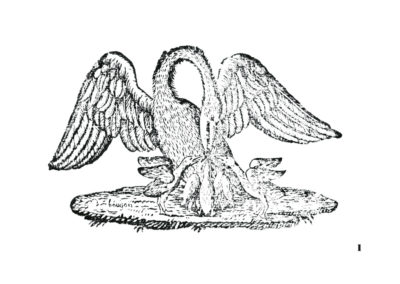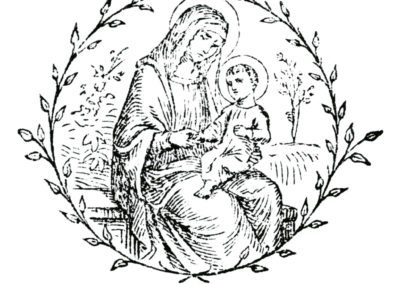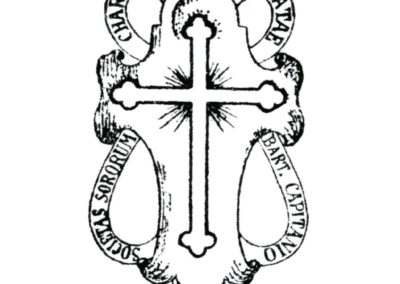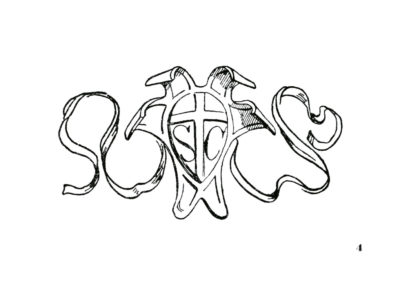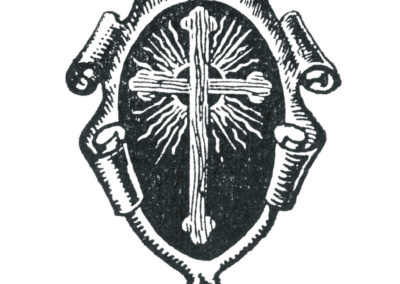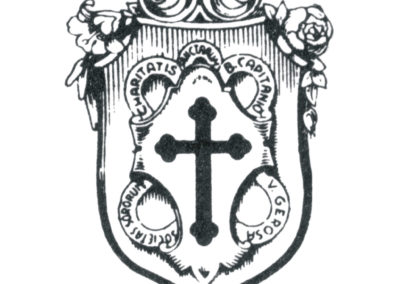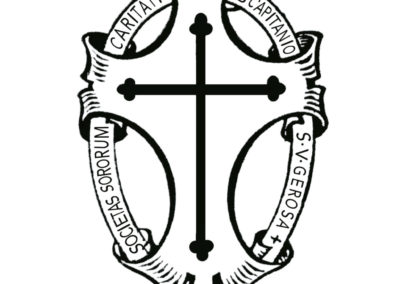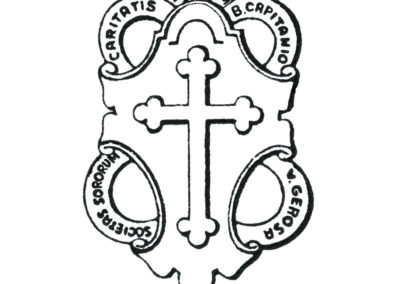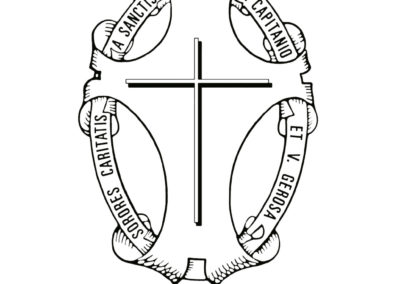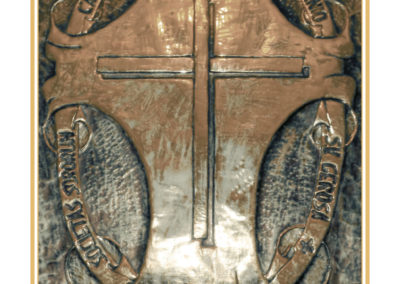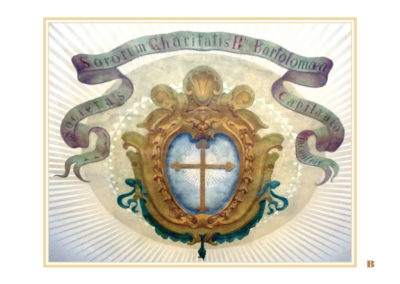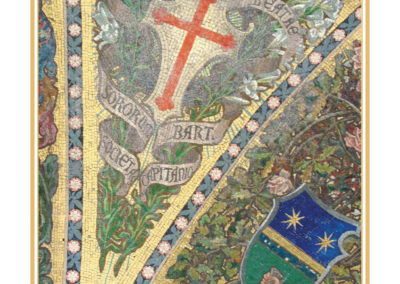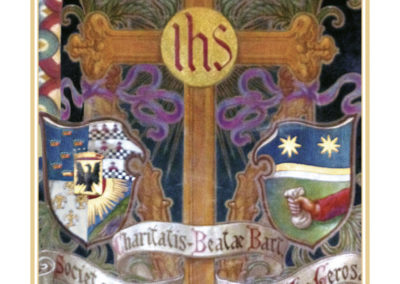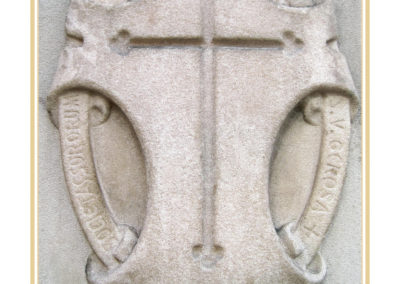To Know and to understand better
The symbolic emblem of the Congregation Sisters of Charity of Saints B. Capitanio and V. Gerosa
commonly known as Sisters of Maria Bambina
Sr Carmela Paloschi
The Emblem is a set of pictures or sculptures that represent the permanent and officially recognized symbol of Countries, persons, families and entities.
1. The emblem that distinguished our Congregation as a juridical entity from 1841 to 1863 was the same one used by the Daughters of Charity of Saint Antida Thouret whose constitutions we had adopted. This emblem can be found in: Istituto ossia Regola e Costituzioni generali della Congregazione delle Figlie della carità sotto la protezione di S. Vincenzo de’ Paoli, Brescia – tipografia vesc. del Pio Istituto 1863 (free translation: Institute, that is Rule and general Constitutions of the Congregation of the Daughters of Charity under the protection of St Vincent de Paul).
It represents the pelican bending over its own breast to feed its young with fish carried in its sack. Hence, a symbol of charity. It is also an allegory of Christ on the cross, when his side was pierced, blood and water came out, source of life for men.
Later on the Institute adopted its own emblem, in black and white, which for some time underwent some variations; we have no idea of who the designers are. The emblem put on the documents and in publications of the Congregation, such as: Life of the Blessed Capitanio, Life of St Gerosa, History of the Institute, Rule of Life, Acts of the General Chapters, Decrees for the erection of religious provinces, circular letters of the Superior General…
2. In the Direttorio per i ministeri esterni delle Suore della carità della ven. Capitanio sotto la protezione di S. Vincenzo de’ Paoli – Trento, ed. Artigianelli, 1898 (Directory for the external ministries of the Sisters of Charity of the Venerable Capitanio under the protection of St Vincent de Paul), there appears the image of Mary sitting upon a low wall in a garden with Baby Jesus on her knees; a perfect circle formed by olive branches sets the limits of the rural scene. In the Bible (Gen 8:11) we find that when the waters of the universal deluge receded, a dove came back to Noah with a new olive branch to announce to him that the earth and the heavens reconciled themselves again. From that moment the olive branch became the symbol of re-birth – because the earth was blooming again – and of peace, attesting the end of punishment and marking God’s reconciliation with men. In the N.T. Jesus was the cause of reconciliation and peace for humanity. The circle formed by a unique line whose edges merge into one into the other, is the symbol of eternity and, of course, of perfection, completeness; besides, the boarder determines the inside surface which is definite while the outer one is infinite. Maybe, this was not a true and real emblem, however, the subject is meaningful and dear to us.
3. In 1926 the Vita illustrata della beata Bartolomea Capitanio (Illustrated life of the blessed Bartolomea Capitanio), di M. Cantelli Riva, and in 1928 the Direttorio delle suore di carità della B. Bartolomea Capitanio (Directory of the Sisters of Charity of the Blessed Bartolomea Capitanio) by Mother V. Starmusch (formed mostly by regulations already printed in 1898 and by manuscripts of the departed Mother A. Ghezzi), the life of La beata Gerosa (The blessed Gerosa) by A. Tamborini of 1933 bear on the front page a real emblem split into partitions: in the central point a cross irradiates rays from the intersection of the arms, clearly outlined against the background casting over it its same shape amplified. In the scroll it is written in Latin: Societas sororum charitatis beatae Bart. Capitanio (Society of the Sisters of Charity of the Blessed Bartolomea Capitanio).
4. The bibliography of the La venerabile suor Vincenza Gerosa – Vita popolare (The venerable Sr. Vincenza Gerosa – Popular Life), printed in Venice in 1931 with the foreword of Cardinal Patriarch
Pietro La Fontaine, and the volumes of the History of the Institute by Sr. A. Prevedello bear an emblem which recalls the almondshaped coat of arms. The central space is divided into four parts by the dominating cross, almost in relief; in the two lower panels, under the horizontal arm, there are two letters: ‘S’ on the left side and ‘C’ on the right side which stand for Societas Charitatis; these
plain ornamental elements give movement to the emblem.
5. Sr. A. Prevedello writes Santa Vincenza Gerosa, confondatrice delle suore di carità (St Vincenza, co-foundress of the Sisters of Charity), published in Vicenza in 1948. On the front page there is a very plain emblem: against the black central space a cross shines, traced by white lines and surrounded by rays. The cross was very dear to this saint who used to repeat: «Whoever knows the Crucified one, knows everything; those who know him not, know nothing (MAZZA, VG, 92) and the «Crucified Lord is a great book to meditate upon and live» (ib, 298); an oval frame with curling decorations surround it.
6. Sr. Maria Clara Bianchi in 1959 published Il simulacro e il santuario di Maria Bambina (The simulacrum and the shrine of Maria Bambina) Ed. Stella Maris, Milan, which illustrates the origins and the reasons of the veneration of the Holy Infant Mary in our religious family. On the back cover of the book there is the printing of the emblem which at first sight makes us imagine a standard due to its floral decorations in the upper part: a rose and a lily, joined together by ornamental spirals. Basically, it is an oval coat of arms sharp pointed in the lower part; in the vast white space there dominates a black cross with its three-lobed leaf endings (this particular element is similar to the Greek clover); a twisting ribbon passing through pre-set ‘loops’, bear the inscription: Societas sororum charitatis sanctarum B. Capitanio V. Gerosa (Society of the Sisters of Charity of the saints B. Capitanio and V. Gerosa).
7. In 1964 there was printed the first issue of La nostra anagrafe in cielo (Our civil registry in heaven), which, as Mother C. Baldinucci states that it is a sign of gratitude towards the departed sisters, between 1832 to 1963 (almost 6,000), the «great ones and humble ones, all dear to us». The emblem printed on the back cover portrays, as the previous one, a black cross in white central space, slightly convex, with the three-lobed endings; the inscription in capital letters, run spaced at regular intervals into four double curly folding corresponding to the four ends of the cross, stating: SOCIETAS
SORORUM CARITATIS S. B. CAPITANIO S. V. GEROSA (Society of the Sisters of Charity of St B. Capitanio and of St V. Gerosa). Notice that the letter ‘h’ has been dropped in the word caritatis.
8. Emblem n. 8 was put in the heading the Decrees of erection of the religious provinces and in the collection of the Circular Letters of our Mothers up to Mother A. Campanile (1987) on the back cover, while on the front page was printed the emblem n. 7. The central space is white as well as the cross, but the cross is marked by a black contour and the trefoil arms; the lower part of the emblem is a three-lobed, while the upper part represents a semi cycle lying on two pedestals; the motto Societas sororum/caritatis/ sanctarum/B. Capitanio/V. Gerosa runs along fragmented ribbons situated upon five little arches with ornamental motifs.
9. From 1988 onwards a standard emblem is adopted: the constant element is the white and stylized Latin Cross, characterized, on the right side of the vertical arm, and under the horizontal one, by the black projection coming from a source of light from North-West: a double backwards fold, in correspondence with the four ends of the cross, acts as a loop to the inscription which at this stage is complete and definitive: Sorores caritatis a sanctis B. Capitanio et V. Gerosa.
This is the official denomination of the Institute rectified by the Sacred Congregation for religious in 1950 (signed by the secretary P.M. Larraone) and in 1958 (signed by card. V. Valeri) so as to avoid confusion with other Institutes. However, due to the veneration of the image of Maria Bambina in our ‘Sanctuario’ in Milan, we are commonly known as «Sisters of Maria Bambina».
The emblem could also be made by different techniques: a fresco, or stone, marble, wooden bas-relief fitted in frames more or less highly decorated.
A. In Lovere (BG) – «Conventino» (ex casa Gaia), mother house of the Institute, along the corridor on the second floor, reserved for the sisters’ residence, close to the ‘room of the chest of drawers’ where «before a holy picture of the Blessed Virgin Mary placed between two lit candles (Bartolomea and Vincenza), on their knees, with the utmost devotion, made, through the hands of Mary, the offering of themselves and of their possessions to God and consecrated themselves entirely to the works of charity in service of the poor, in the manner most pleasing to God» (MAZZA L. I., Della vita e dell’Istituto della venerabile Maria Bartolomea Capitanio, II, 79), we can admire an embossed copper representation of the emblem: in the centre point there is the cross which is equal to the one
described in picture number 9; only the motto is slightly different: Societas sororum caritatis S. B. Capitanio S. V. Gerosa. We can see that before the names Bartolomea and Vincenza there is an abbreviation ‘S’ standing for Sanctae, this makes us think that the emblem was designed after 1950, the year of their canonization.
B. Again at the «Conventino», upon the ceiling of the hall on the first floor – at present «European Novitiate» – from the centre point where the chandelier hangs is a polychrome fresco, rich in decorative elements, in the midst of which there is a representation of the emblem in its original form. In the blue background which is toned down nearly white towards the centre, the golden cross with trefoil arms is dominating, while a beam of golden rays stretches out from the central point. Around there is a frame – which seems in the shape of a heart – rich in floral motifs and various curly folding leaves which at the bottom take the form of a blue ribbon or a lace. At the background there are two pale brown ovals, separated by white geometric designs (small circles and triangles) surrounded by a blue radial pattern, which recalls the sun, symbol of comfort, life and optimism largely infused. Overhanging above the whole pattern there is a gleaming blue scroll with grandiose and elegant spirals stating: Societas sororum charitatis B.tae Bartolomeae Capitanio et Vincentiae.
C. Upon the right hand-side of the flight of stairs leading to the entrance of the Santuario we can admire a hanging balcony, which is the internal liaison with the tribunes; below this, in the small ribbed vaults, we can see the emblems of the Capitanio and Gerosa families, one on the right and the other on the left, while the centre is decorated with the emblem of the Congregation. This has the shape of a sail or of an acute triangle with the top up side down; the golden background is dominated by the red cross with the three-lobed arms, surrounded by two branches of garden lilies, symbol of innocence and purity; the ribbon with the inscription Societas sororum charitatis beatae Bart. Capitanio unites and bounds them as a bunch of flowers from the flower-shop; the golden contour sheds light upon the green leaves and white flowers; a second contour decorated with little roses and leaves divides the emblem of the Congregation from that of the Capitanio and Gerosa families.
D. On the inside wall of the Sanctuary, at the back of the church, on the right hand side looking towards the altar, a fresco gathers in itself the three above mentioned emblems. In the black background there is a brown, trefoil cross; at the intersection of the arms a new element appears, a host with the initials JHS (Jesus Hominum Salvator=Jesus saviour of men); the spaces above are
supplied with the large leaves of two palms growing at the foot of the cross (symbol of fertility and long life), in the lower spaces there are: on the left the Capitanio family emblem and on the right that of the Gerosa family. At the bottom a twisted ribbon in the form of a parchment shows the inscription: Societas sororum charitatis – Beatae Bart. Capitanio et Vinc. Gerosa. A decorated frame with
tiny coloured arches and the outside blue contour enfold the set creating the idea of a show case.
E. On the right hand side of the entrance door of the General House in Milan at via S. Sofia, 13, a plain rough marble, beige with antique effects, besides the inscription: Santuario di Maria Bambina, represents a three dimensional, high relief emblem of the Congregation according to the emblem pattern described in number 7. Obviously it illustrates the cross and the denomination of the Congregation Societas sororum / caritatis / S. B. Capitanio / S. V. Gerosa. The porous marble surface reduces the process of deterioration due to the bad weather to which it is continually exposed.
The cross is the symbol that unifies the various representations of our emblem because «a sister of charity is first of all a ‘redeemed person’, freed by Christ, moulded by His munificent love, regenerated
and rendered capable of putting into practice Jesus’ regenerating love in today’s history for the benefit of humanity…
Each member lives her religious-apostolic consecration according to the typical dynamics of the mystery of death and resurrection of our beloved Redeemer: through total surrender of our whole being we expropriate ourselves to be totally offered to our brethren. This is the way to free ourselves and the others, a process that leads us to loose even our own life in order to generate new life in us and in the persons we serve in our apostolic life… ‘May the most amiable Redeemer, make us his true followers’ is the seal of her promemoria and our formula of perpetual profession in this Institute ‘totally founded on charity’» (KERSBAMER Sr. C. in May the Redeemer make us His true followers, 1983, ll8.120.125).

